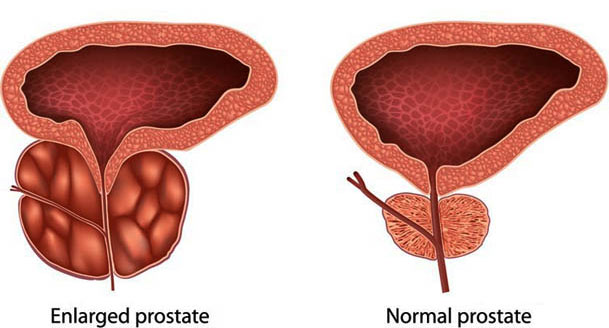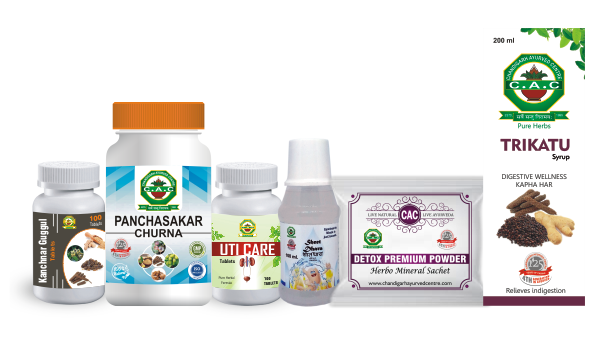
Benign Prostatic Hyperplasia?
- October 14, 2019
- Posted by Dr. Vaidya Karanvir Singh
- 0 Comment(s)
Benign prostatic hyperplasia (BPH) is a very common disease of old male persons. Some recent epidemiological studies have revealed that to large extent lifestyle factors associated with metabolism including obesity, blood glucose, exercise, and diet also contribute substantially to the development of these conditions.
BPH is defined as an enlarged prostate gland that can cause uncomfortable urinary symptoms, such as blocking the flow of urine out of the bladder.
The prevalence of BPH is age-dependent, with initial development usually after 40 years of age and more than 50% of men in their 60s and up to 90% of men in their 70s -80s years have some symptoms of BPH. The prostate gland increases in size as the age advances, making BPH one of the most common age-related conditions in men.
What are the Causes of Benign Prostatic Hyperplasia?
The most common causes for benign prostatic hyperplasia are given below –
- Inflammation of the prostate (prostatitis)
- Narrowing of the urethra (urethral stricture)
- As a result of previous surgery
- Bladder or kidney stones
- Urinary tract infections
- Problems with nerves that control the bladder
- Cancer of the prostate or bladder
What are the Signs and Symptoms of Benign Prostatic Hyperplasia?
The symptoms in people who have prostate gland enlargement vary, but symptoms tend to gradually worsen over time. Common signs and symptoms of BPH include:
- Frequent or urgent need to urinate
- Increased frequency of urination at night (nocturia)
- Difficulty while passing urine
- Irregular urine stream
- Dribbling at the end of urination
- Inability to empty the bladder
- Urinary tract infections
- Inability to urinate
- Blood in the urine
What is the Ayurvedic view of Benign Prostatic Hyperplasia?
In Ayurveda, BPH is correlated with ‘Ashtheela’ or ‘Vatashtheeta’ and ‘Mutragranthi’. The term Ashtheela denotes the consistency of part like very hard and rounded in shape. The space between the rectum and urinary bladder leads to a hard (like stone), immobile and prominent growth. This growth, in turn, produces obstruction to the stool, urine and flatus, distention of the bladder, and pain over the suprapubic region. The description of Asthheela is more closely resembles with BPH rather than Mutragranthi. In Astheela, obstructive uropathy occurs from outside the urinary passage due to enlargement of the prostate and leads to compression on the urethra.
What is the Ayurvedic Treatment of Benign Prostatic Hyperplasia?
Ayurveda has numerous herbs that are proven to the best remedies for benign prostatic hyperplasia. The herbs cure this condition naturally without causing any side effects. Chandigarh Ayurved Centre had made a ‘’Benign Prostatic Hyperplasia Care Kit’’, that involves a total of 6 products – Detox premium powder, Trikatu tablet, Sheet dhara syrup, Uti Care Tablet, Panchasakar churna, and Kanchanaar guggulu. The kit has no added preservatives and is free from side effects.
ALL PRODUCTS DESCRIPTION IN DETAIL:
Table of Contents
1. Detox Premium Powder:
Detox premium powder is made up of natural herbs and bhasmas like iloy satav, gandhak rasayan, tal sindoor, shankh bhasma, moti pishti, akik pishti, etc. The powder relieves the burning sensation, irritation, discomfort, and normalizes the aggravation of the pitta dosha.
Recommended Dosage – Take 1 sachet twice daily with normal water.
2. Trikatu Syrup:
Trikatu syrup is widely used to balance the aggravated Tridosha and mainly composed of Ginger (Zingiber officinale), Pippali (Piper longum), and Maricha (Piper nigrum). The ingredients used in the formation of the syrup reduce the symptoms and prevent further enlargement of the gland.
Recommended Dosage – Take 2 teaspoonfuls thrice daily.
3. UTI Care Tablets:
UTI Care Tablet is an herbal formulation of Sajjakshar (Bergenia lingulata), Gokshura (Tribulus terrestris), Punarnava (Boerhavia diffusa), etc. The capsule cures the flow of urine, relieves the burning sensation, swelling, pain, and discomfort.
Recommended Dosage – Take 1 Tablet twice daily with normal water.
4. Sheet Dhara Syrup:
This is the ayurvedic formulation of Ajwain satv, Peppermint, and Mushak kapoor that balances the vata and pitta dosha. The syrup has coolant properties thus it is very beneficial to cure abdominal pain, discomfort, and improves the metabolism of digestion.
Recommended Dosage – Take half teaspoonful of this syrup in half a cup of water. Drink this mixture twice daily on an empty stomach.
5. Panchasakar Churna:
The churna has best results in the detoxification of excess toxins from the body and maintains the proper metabolism. It is made up of a total of 5 ingredients – Shunthi (Zingiber officinale), Haritaki (Terminalia chebula), Svaran patri (Cassia angustifolia), Shatapushpa (Foeniculum vulgare),Sauvarchala lavana (Rock salt). The powder reduces the inflammation, redness, relieves constipation, abdominal discomfort, etc. and also prevents it from re-occurring.
Recommended Dosage – Take 1 teaspoonful at bedtime with lukewarm water.
6. Kanchnaar guggulu:
Kanchnaar guggulu has anti-bacterial, analgesic, anti-oxidant, anti-inflammatory properties that subside the symptoms of BPH quickly and is very beneficial for weight loss, any type of cyst, thyroid, etc. Each tablet consist of Amalaki (Emblica officinalis), Haritaki (Terminalia chebula), Elaichi (Elettaria cardamomum), Maricha (Piper longum), etc.
Recommended Dosage – Take 1 tablet twice daily with normal water.
What is the Panchakarma Treatment of Benign Prostatic Hyperplasia?
Besides medicines, Panchakarma has also the best result in detoxification and the management of the benign prostatic hyperplasia. Chandigarh Ayurved Centre had performed the therapies by experienced therapists under the guidance of Panchakarma Doctors. The description of therapy are given below –
Basti- Karma therapy (Enema Therapy): Vata dosha is the main causative factor in the genesis of benign prostatic hyperplasia. To pacify the vitiated Vata Vatanulomana drugs and Vasti karma is the best modality. Vata pacifying Vasti (ie.uttar vasti) is effective in reducing the symptoms of BPH with a decoction of Dashmool, Gokshuradi, and Varunadi Gana drugs, etc.
Healthy Diet and Lifestyle –
- Yoga & Exercise could help to reduce the risk of BPH. Regular practicing of yoga may also help to improve the symptoms of BPH, as it can help to strengthen the muscles in the pelvic floor. The following yoga poses are good for strengthening the pelvic floor and may help to improve symptoms of an enlarged prostate and also reduces the stress. Do perform yoga poses such as Baddha Konasana, Dhanurasana, Virasana, Supta Padangusthasana.
- A diet that is rich in fruits, vegetables, and healthy fats is thought to protect the prostate. The person should increase the intake of Tomatoes, Berries, Onion, Garlic, Broccoli, Nuts, etc.
- There are some food items that cause severe symptoms in the person having prostatitis, thus one should prevent from BPH by avoiding the food such as dairy products, red meat, high intake of alcohol, coffee, etc.
- The patient can choose whole-grain bread instead of white bread, and choose whole-grain pasta and cereals.

Dr. Vaidya Karanvir Singh is the younger Vaidya in Chandigarh Ayurved & Panchakarma Centre. He is the fourth generation in his family who is practicing as a general consultant in Ayurved & Panchakarma treatment at Chandigarh. In his practice, he had treated more than 1 Lakh Plus patients worldwide.



